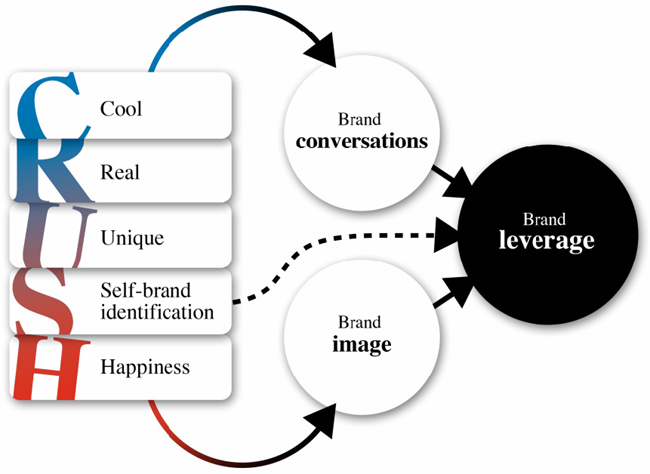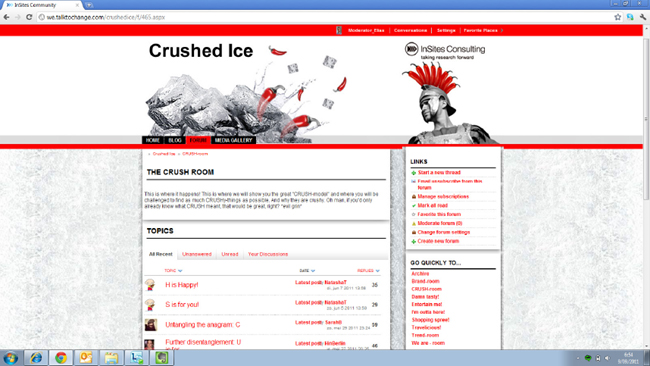Simona Sbarbaro, Joeri Van den Bergh, Elias Veris and Tom De Ruyck
MTV Networks, Italy and InSites Consulting, Belgium
MTV Networks, Italy and InSites Consulting, Belgium
IT’S SO UNCOOL TO THINK YOU’RE COOL
At the end of the 1980s and start of the 1990s youth marketing was on
the rise. Marketers were in search of new segments and target groups to
conquer and to them the young consumer was a rather easy target. If
only you shouted hard enough through specific youth media like MTV that
you ought to use brand X to be a cool hipster or sexy chick, your
success was guaranteed. Commercial media were relatively new, global
brands were by definition cool and young people loved to submerge in
consumerism. Buying stuff made them feel independent and grown-up. And
yuppie culture endorsed the glamorous appeal of brands that dictated how
to dress, behave, walk and talk.
Today, twenty years later, things have dramatically changed. This new
youth generation, called Generation Y or Millennials, has been
bombarded with commercial messages from their birth. They have learned
to filter out all those loud marketing messages and their parents
empowered them to have an opinion of their own and never merely believe
whatever somebody is proclaiming. But the global brands are still there.
So are the commercial media. And there must be countless times more
choice of both. To survive in a cluttered and fragmented world flooded
with products and alternatives, today’s youth uses collective peer
wisdom and social connections. They believe in what their best friends
and parents are telling them and self-consciously explore the roads they
want to take rather than follow whatever the next image advertising
wants them to believe.
And what are brands to do now? They have lost their role model or
oracle status. Although the current youth generation still embraces cool
brands, the ones that just claim they are cool won’t even reach their
radar. They decide themselves what’s cool and what’s not. “Coolness” is
not a brand personality trait that you can deliberately plan or chase.
You have to earn the status of ‘cool brand’.
THE CRUSH MODEL AS A BACKBONE
In How Cool Brands Stay Hot. Branding to Generation Y, Joeri
Van den Bergh and Mattias Behrer describe a model, based on years of
youth experience and quantitative Gen Y research in several European
markets, to connect with this new generation of consumers (Van den
Bergh, Behrer, 2011). The brand CRUSH model (see figure 1) summarizes
the five aspects that are key in developing branding strategies with
Generation Y.
The five components of the CRUSH model are:
-
Coolness: What does it mean to be a cool brand for this generation? How do you achieve a cool status and why should you bother?
-
Realness: Brand authenticity is a key aspect that discerns
long-term winning brands from fads. With Generation Y, authenticity is
attained in another way than the traditional approach of claiming
origin, heritage or history.
-
Uniqueness: A clear positioning based on a sustainable brand DNA
will increase impact among youngsters. This generation is craving for
anchor brands in a fragmented world. But how do you assert uniqueness
when most innovations are copied within a couple of months’ time?
-
Self-identification with the brand: Gen Yers will only feel
emotionally connected with your brand when it feels like a friend to
them. This implies that your brand should reflect their diverse
lifestyles. A better understanding of their identity construction will
make your brand fit in with youths’ lives while embracing diversity.
-
Happiness: Popular youth brands know how to leverage from positive emotions and avoid arousing negative ones.
Based on their research work, Van den Bergh and Behrer concluded that
brands that are highly rated on each of the CRUSH elements by
Generation Yers are more likely to experience increased word-of-mouth
and a more positive brand image eventually leading to a better NPS (Net
Promoter Score).

FIGURE 1, THE CRUSH MODEL
Since the model was developed using European data, MTV Networks
(present in many developing and global markets) wanted to find out how
these five components are translated regionally around the world. Are
they valid to explain why youth in America, Asia, Africa, Eastern and
Western Europe perceive something as “cool” or “likeable”? To enhance
its connection with the current youth generation around the world, MTV
was looking for inspiration and input to challenge the new global
positioning and brand brief consisting of both re-evaluated brand values
and brand personality. Exploring the CRUSH dimensions in a more
qualitative diagnostic way would help MTV to further shape its brand
positioning and brand focus while InSites Consulting could investigate
in what way the five dimensions could be operationalized for future
qualitative research approaches through consumer communities.
HOW WE DID IT: A GLOBAL ONLINE COMMUNITY OF INFLUENTIAL YOUTH
To obtain an answer to these questions InSites Consulting and MTV
Networks teamed up to create “Crushed Ice”, a global online community of
influential youth discussing whatever they are observing around them in
their local cities during six consecutive weeks. We started from 150
carefully selected urban recruits, aged 18-29 years and living in 15
cities around the world (in alphabetical order: Amsterdam, Berlin, Cape
Town, Dubai, Istanbul, London, Mumbai, New York, Paris, Rio, San
Francisco, Shanghai, St Petersburg, Stockholm and Sydney). Recruitment
sources were panel brokers as well as cool blogs such as holycool.net
and contributors to the MTV global Sticky panel. All of them had to
pass a TOEFL test to make sure they could fluently communicate with each
other in English. To ensure all of the participants would be rightfully
placed to feed our objectives, we used innovator-gatekeepers
standardized scales as well as open ended questions tracking their
leisure time activities, sports, frequently visited websites and social
networks as well as devices owned. Half of the participating Gen Yers
were studying, the other half were already working. Each of them had to
have an active interest in at least one out of the five topics we were
about to discuss in the community:
-
shopping and fashion;
-
in-home entertainment (movies, games, technology);
-
going out;
-
food and drinks;
-
travel.
Together the participating Millennials from all five continents have
produced 1,589 posts. The community platform was “live” after a kick-off
session in the second half of April 2011 until early June 2011.
The platform consisted of five different rooms and a blog section
(see fIgure 2). The five rooms in the research community were the
following:
-
the We Are room: where we got to know the participants, the
different cities they are living in and their own cultural background;
-
the Crush room: where we tried to understand what products,
brands and hotspots they were linking to our CRUSH dimensions. The core
idea was to understand the reason-why something would be perceived a
cool, real, unique, like themselves or bringing happiness as well as to
detect which consumer trends are related to each of the different
components;
-
the Trend room where we asked global youth what trends they would
name as well as the ones they feel are completely dead at present;
-
the Brand room in which we confronted our participants with stuff
that we thought was cool or uncool and just wanted their critical view
on;
-
the Secret room: this was a section of the site only accessible
to the participants who were selected as being interested and an expert
in one of the five themes of the community stated above. So we actually
had five secret rooms not accessible to all participants but just to the happy few that were selected by us, well by themselves actually…

FIGURE 2
The blog section was used to enhance community feeling and boost
intrinsic motivation of all participants. Every week at least two blog
messages were posted: a video message of the moderator or client
involved and a hot/cool gimmick we discovered and wanted to share with
the participants to receive their feedback.
Elements of Gamification
More and more effort is currently being focussed on trying to engage
people for longer periods of time in certain initiatives. These can be
marketing-related, but also link to social or environmental purposes. A
number of authors and speakers use the term Gamification for this (Gabe
Zicherman, Sebastian Deterding), and operationalize this renewed focus
on engagement through the use of techniques that stem from the world of
gaming.
In the ‘Crushed Ice’ community, a number of these game mechanics
were used to boost participation and longer term engagement. A system
of points (granted for each meaningful post) that add up to levels (five
in total) that become gradually harder to reach, was in place. When
reaching a level, a reward under the form of access, power or status was
given. Access was granted to hidden pieces of amusing content, for
instance by playing on the meme of how cool brands stay “hot” and giving
a small visual that explains how spiciness of peppers (= “hotness”) is
measured by the Scoville heat scale.
The aforementioned secret rooms
were only accessible to a limited amount of content experts, from a
certain level on, which is also an access-reward. The power reward
consisted of getting the right to write blogposts on the blog section,
which is normally only reserved for moderators. We played on a feeling
of status by having a leader board showing the name of the person and
the number of points and level that he/she has on the homepage.
Furthermore, we motivated respondents to do a certain number of special
actions/posting under certain topics, by granting them a badge. Badges
are “virtual goods” – digital artifacts that have some visual
representation – which are awarded to users who complete specific
activities as soon as they did so (Antin and Churchill, 2011).
We used
badges for activities such as posting self-made pictures from their
city, and also rewarded badges for every letter from the CRUSH acronym.
This way we also induced respondents to keep on participating, playing
on the human desire for completion (collecting all five letters).
Read more: http://warc.com/Content/ContentViewer.aspx?ID=f40c7cb5-069b-40e5-910f-4dee157b8fe3&MasterContentRef=f40c7cb5-069b-40e5-910f-4dee157b8fe3

No comments:
Post a Comment